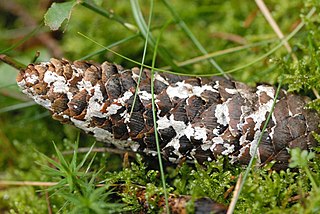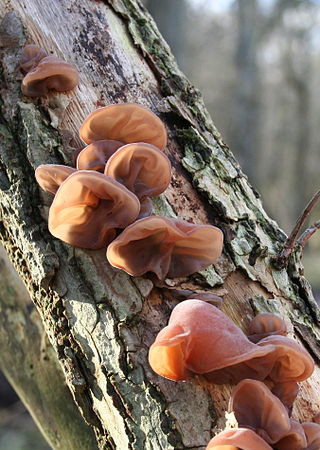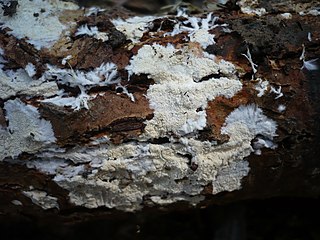
The Polyporales are an order of about 1800 species of fungi in the division Basidiomycota. The order includes some polypores as well as many corticioid fungi and a few agarics. Many species within the order are saprotrophic, most of them wood-rotters. Some genera, such as Ganoderma and Fomes, contain species that attack living tissues and then continue to degrade the wood of their dead hosts. Those of economic importance include several important pathogens of trees and a few species that cause damage by rotting structural timber. Some of the Polyporales are commercially cultivated and marketed for use as food items or in traditional Chinese medicine.

The Gomphales are an order of basidiomycete fungi. Some or all families belonging to Gomphales have been sometimes included in the order Phallales, the now-obsolete Ramariaceae was also previously included in Cantharellales. Recent phylogenetic analyses include in Gomphales the families of the original description of the order by Walter Jülich, with addition of Clavariadelphaceae. According to one 2008 estimate, the Gomphales contain 18 genera and 336 species.

Atheliaceae is a family of corticioid fungi placed under the monotypic order Atheliales. Both the order and the family were described by Walter Jülich in 1981. According to a 2008 estimate, the family contains 20 genera and approximately 100 species. However, many genera formerly considered to belong in the Atheliaceae have since been moved to other families, including Amylocorticiaceae, Albatrellaceae, and Hygrophoraceae. Despite being a relatively small group with inconspicuous forms, Atheliaceae members show great diversity in life strategies and are widespread in distribution. Additionally, being a group strictly composed of corticioid fungi, they may also provide insights on the evolution of fruiting body forms in basidiomycetes.

The Meruliaceae are a family of fungi in the order Polyporales. According to a 2008 estimate, the family contains 47 genera and 420 species. As of April 2018, Index Fungorum accepts 645 species in the family.

The Phanerochaetaceae are a family of mostly crust fungi in the order Polyporales.

The Steccherinaceae are a family of about 200 species of fungi in the order Polyporales. It includes crust-like, toothed, and poroid species that cause a white rot in dead wood.

The Hydnodontaceae are a family of fungi in the class Agaricomycetes. According to a 2008 estimate, the family contains 15 genera and 105 species. It is the only family in the order Trechisporales.

The Auriculariales are an order of fungi in the class Agaricomycetes. Species within the order were formerly referred to the "heterobasidiomycetes" or "jelly fungi", since many have gelatinous basidiocarps that produce spores on septate basidia. Around 200 species are known worldwide, placed in six or more families, though the status of these families is currently uncertain. All species in the Auriculariales are believed to be saprotrophic, most growing on dead wood. Fruit bodies of several Auricularia species are cultivated for food on a commercial scale, especially in China.

Postia is a genus of brown rot fungi in the family Fomitopsidaceae.
The Mesophelliaceae are a family of truffle-fungi in the order Hysterangiales. The family contains 8 genera and 33 species.

The Inocybaceae are a family of fungi in the order Agaricales, the largest order of mushroom-forming fungi. It is one of the larger families within Agaricales. This family exhibits an ectomycorrhizal ecology. Members of this family have a widespread distribution in tropical and temperate areas.

The Lyophyllaceae is a family of fungi in the order Agaricales. A 2008 estimate indicated eight genera and 157 species; as of November 2014, the Catalog of Life lists 13 genera in the family. Lyophyllaceae was circumscribed by mycologist Walter Jülich in 1981.

The Niaceae are a family of fungi in the order Agaricales. The family contains six genera and 56 species. GBIF, accepted 10 genera and 278 species.

Crustomyces is a genus of fungi in the family Cystostereaceae. The widespread genus contains three species.
Adustomyces is a fungal genus in the family Pterulaceae. The genus is monotypic, containing the single resupinate species Adustomyces lusitanicus, found in Europe and Africa. Adustomyces was described by Swiss mycologist Walter Jülich in 1979.
The Vuilleminiaceae are a family of fungi in the order Corticiales. The family in its current sense is based on molecular research and contains just three genera of temperate corticioid fungi.
Membranomyces is a genus of fungi in the family Clavulinaceae. The genus, circumscribed in 1975, contains two species found in Europe and Canada.

Lagarobasidium is a genus of corticioid fungi in the Schizoporaceae family. Circumscribed by Swiss mycologist Walter Jülich in 1974, the genus contain three species.

Leptosporomyces is a genus of resupinate (crust-like) fungi in the family Amylocorticiaceae. The genus is widespread in the Northern Hemisphere and contains 11 species.















